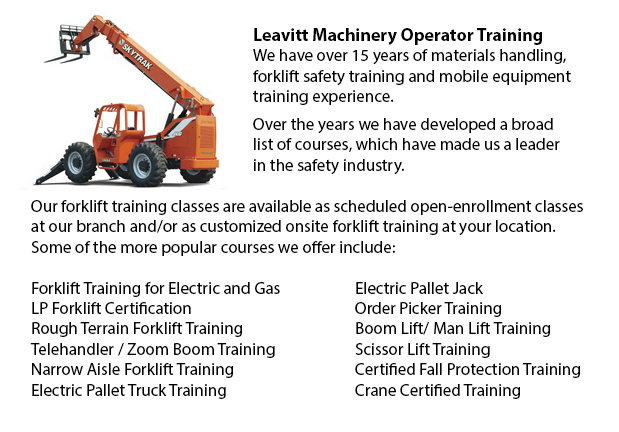
Guelph Telescopic Training - The telescopic handler forklift is more commonly called a telehandler, and is a machine which could lift materials and products to greater heights and has more versatility than a typical forklift. It is often preferred over the traditional masted counterbalance truck (standard and rough terrain). Whether utilized for transporting pallets within a warehouse or for transporting raw materials into the back of a dump truck, the telescopic forklift is an important device. Accredited telescopic handler training is vital to ensure the efficient and safe operation of the unit.
A telescopic forklift is meant to lift heavy objects using an arm, which extends in parts much like a telescope. To choose a telescopic forklift, you must consider how the machine will be used and for how long. Required lift heights and work site terrain need to be considered. Price, warranty, and components are all factors considered in purchasing a telescopic forklift. If you are leasing, you would want to compare delivery costs, prices and terms.
This type of lift truck comes in many sizes, that directly reflects the amount of weight it can load and the heights it can safely lift products to. If the task is to transport supplies into the rear of a pick-up then a small to medium sized telescopic forklift is ideal. Lifting heavier things up higher will require a bigger lift. Careful consideration of how the lift will be utilized helps ensures you will choose the best size for safety and stability.
When selecting this kind of equipment, attachments even need to be considered. Find out from the manufacturer what attachments are available. There are pallet attachments, bucket attachments as well as other attachments for specific reasons.
The variety of tires for the telehandler would depend on the flooring and terrain of the worksite. Smaller units will typically have cushion tires made with rubber all the way through. Cushion tires are appropriate for telehandlers being used within a warehouse with a concrete floor. They provide durability and stability. Pneumatic tires are normally on larger units used on varied, outdoor terrain where there might be dirt, rock, concrete and asphalt. They give the best traction and articulation.
-
Guelph Warehouse Forklift Training Classes
Guelph Warehouse Forklift Training Classes - Warehouse training classes exist for the reason of raising awareness regarding common warehouse hazards. Students learn the important safety procedures that are necessary to warehouse safety. An emphasis i... More -
Guelph Forklift Operator Certification
Guelph Forklift Operator Certification - Certification for forklifts are needed to guarantee the safe use of forklifts for those employers in construction, industrial and warehouse settings. The training has to involve a method of education plus some... More -
Guelph Crane Training School
Guelph Crane Training School - The crane training school offers industry-relevant programs. Courses provide trainees with learning results that match current industry demands. Our small class sizes combine hands-on experience and theory. Our qualifie... More -
Guelph Heavy Equipment Training Programs
Guelph Heavy Equipment Training Programs - At whatever given construction site, there are usually various kinds of machines that are ready to be used. These heavy and light equipment need both operators to run them and mechanics to fix them. Apprenti... More -
Guelph Skid Steer Ticket
Guelph Skid Steer Ticket - On a skid-steer loader, the lift arms are at the side of the driver together with pivot points at the back of the driver's shoulders. This makes them different compared to a traditional front loader. Because of the operator... More -
Guelph Zoom Boom Ticket
Guelph Zoom Boom Ticket - Zoom Boom Training focuses on correctly training prospective operators on variable reach forklifts. The training goals include gaining the understanding of the equipments physics and to define the tasks of the operator. This... More -
Guelph Heavy Equipment Training
Guelph Heavy Equipment Training - Commonly, the different types of heavy equipment training are divided into 2 categories of machinery: those that have rubber tires and tracked vehicles. Tracked vehicles consist of items like for instance bulldozers,... More -
Guelph Aerial Lift Safety Training
Guelph Aerial Lift Safety Training - Each year, there are roughly 26 construction deaths due to the use of aerial lifts. Nearly all of the craftsmen killed are laborers, electrical workers, carpenters, painters or ironworkers. Nearly all deaths are c... More

Forklift Certification Guelph
TOLL FREE: 1-888-254-6157
Guelph, Ontario
forkliftcertificationguelph.com
Email Us
About Us


